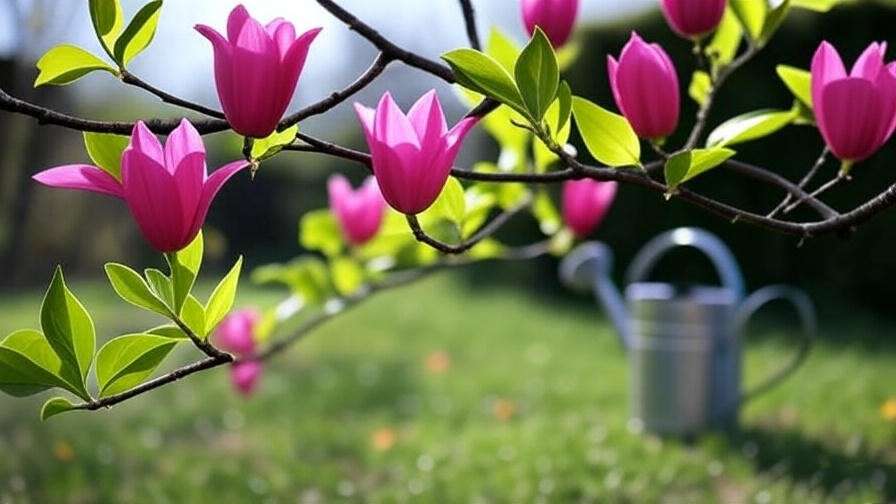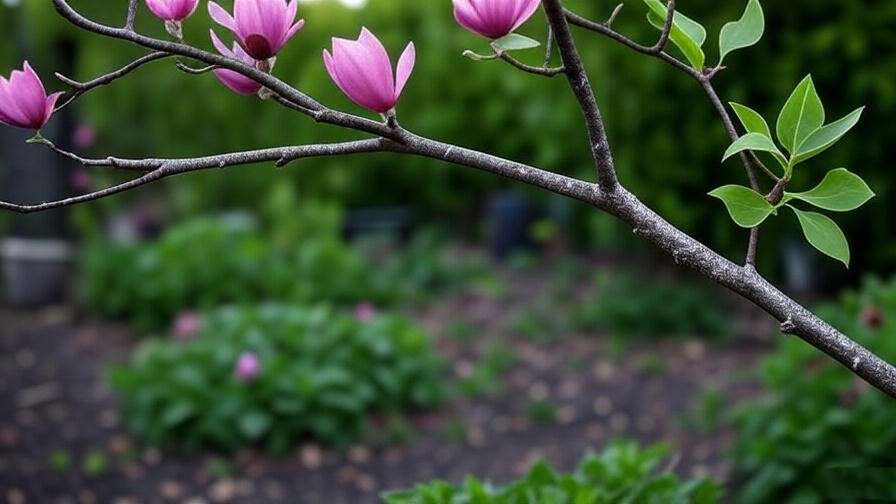Imagine a tree that transforms your garden into a breathtaking display of pink tulip-shaped blooms, stealing the show every spring! 🌸 The pink tulip tree, a stunning cultivar of Liriodendron tulipifera (like ‘Aureomarginatum’) or related magnolia hybrids, is a dream for plant enthusiasts seeking vibrant beauty and eco-friendly charm. Whether you’re a novice gardener or a seasoned arborist, growing and caring for a pink tulip tree can be rewarding yet challenging without the right know-how. This comprehensive guide, backed by horticultural expertise, delivers actionable tips to plant, nurture, and maintain a thriving pink tulip tree. From choosing the perfect spot to tackling common issues, we’ll ensure your tree flourishes for years to come. 🌳
1. Understanding the Pink Tulip Tree 🌳
1.1 What Is a Pink Tulip Tree?
The pink tulip tree, often a cultivar of Liriodendron tulipifera or a magnolia hybrid, is a deciduous ornamental tree celebrated for its tulip-shaped leaves and vibrant pink or pink-tinged flowers. Unlike true tulips, its blooms resemble delicate cups, adding a unique flair to landscapes. Native to Eastern North America, Liriodendron tulipifera thrives in USDA Hardiness Zones 4-9, making it adaptable to various climates. Some cultivars, like ‘Aureomarginatum,’ feature variegated leaves, while magnolia hybrids may offer deeper pink hues. This tree’s fast growth (1-2 feet per year) and striking appearance make it a favorite for gardeners seeking a statement piece.
1.2 Why Choose a Pink Tulip Tree for Your Garden?
A pink tulip tree is more than just a pretty face. Its vibrant blooms and lush foliage create a stunning focal point, enhancing curb appeal. 🌼 Environmentally, it provides shade, supports pollinators like bees and butterflies, and attracts birds with its seeds. Its versatility suits large gardens, parks, or even urban settings with enough space. For those searching for a low-maintenance yet high-impact tree, the pink tulip tree delivers year-round interest, especially during its spring bloom and golden fall foliage. Choosing this tree fulfills the desire for beauty, sustainability, and ecological benefits in one package.
2. Planting Your Pink Tulip Tree 🌱
2.1 Choosing the Right Location
Selecting the perfect spot is critical for your pink tulip tree’s success. These trees thrive in full sun (6+ hours daily) but tolerate partial shade in hotter climates. Opt for well-drained, fertile soil with a slightly acidic pH (5.5-6.5) to promote healthy roots. Since mature trees can reach 50-80 feet tall and 30-50 feet wide, ensure ample space to avoid crowding. Check for overhead obstacles like power lines and underground utilities before planting. A well-chosen location minimizes future stress and maximizes growth potential.
2.2 Best Time to Plant
Timing is everything when planting a pink tulip tree. Early spring or fall is ideal, allowing roots to establish before extreme heat or cold. In warmer climates (Zones 7-9), fall planting gives roots a head start, while spring works better in colder regions (Zones 4-6) to avoid frost damage. Expert Tip: Avoid planting during summer heatwaves or deep winter freezes, as these conditions stress young trees and hinder root development.
2.3 Step-by-Step Planting Guide
- Select a Healthy Sapling: Choose a nursery tree with a strong root ball, vibrant leaves, and no signs of pests or disease. Look for a straight trunk and balanced branching.
- Prepare the Site: Dig a hole twice as wide and as deep as the root ball. Loosen soil to encourage root spread. Amend with compost if soil is poor.
- Plant the Tree: Place the tree in the hole, ensuring the root collar is level with the ground. Backfill with soil, tamping gently to remove air pockets.
- Water Thoroughly: Soak the root zone with 1-2 gallons of water to settle the soil.
- Stake if Needed: Use stakes for support in windy areas, but remove them after one year to avoid dependency.
- Mulch: Apply a 2-3 inch layer of organic mulch (e.g., wood chips) around the base, keeping it away from the trunk to prevent rot.
Common Mistakes to Avoid: Planting too deep, overwatering, or neglecting to loosen compacted soil can stunt growth or kill young trees.

3. Caring for Your Pink Tulip Tree 🌿
3.1 Watering Requirements
Proper watering is crucial, especially for young pink tulip trees. During the first two years, provide 1-2 inches of water weekly, ensuring the soil stays moist but not waterlogged. Use a soaker hose or drip irrigation for even distribution. Mature trees are more drought-tolerant but benefit from supplemental watering during prolonged dry spells. Expert Insight: Spread a 3-inch layer of mulch around the base to retain moisture and regulate soil temperature, reducing watering frequency.

3.2 Fertilizing for Optimal Growth
Fertilizing supports vigorous growth and vibrant blooms. In early spring, apply a balanced granular fertilizer (e.g., 10-10-10) around the drip line, following package instructions to avoid over-fertilization. For eco-conscious gardeners, organic options like compost or well-rotted manure work well. Avoid fertilizing late in the season, as this can stimulate growth vulnerable to frost. Pro Tip: Conduct a soil test every 2-3 years to monitor nutrient levels and adjust fertilization accordingly.
3.3 Pruning and Maintenance
Pruning keeps your pink tulip tree healthy and shapely. Perform major pruning in late winter or early spring before new growth begins. Use clean, sharp shears to remove dead, damaged, or crossing branches, promoting airflow and reducing disease risk. Shape young trees to establish a strong central leader. Avoid heavy pruning, as it can stress the tree. Regular maintenance includes clearing fallen leaves and inspecting for pests or disease. Tool Tip: Sterilize pruning tools with rubbing alcohol to prevent disease spread.

4. Common Problems and Solutions 🐛
4.1 Pests and Diseases
Pink tulip trees are relatively hardy but can face pest and disease challenges:
- Pests: Aphids, scale insects, and spider mites may attack leaves or stems. Use insecticidal soap or neem oil for organic control, or consult a professional for severe infestations.
- Diseases: Verticillium wilt (fungal), leaf spot, and powdery mildew are common. Ensure good air circulation and avoid overhead watering to prevent fungal issues. For wilt, remove affected branches and improve soil drainage.
- Prevention: Regular inspections, proper spacing, and healthy soil practices reduce risks. Expert Recommendation: Work with a local extension service for region-specific pest management advice.

4.2 Environmental Stress
Stress signs include yellowing leaves, wilting, or stunted growth. Causes may include:
- Poor soil quality: Test and amend soil with organic matter.
- Overwatering or underwatering: Adjust to a consistent schedule.
- Extreme weather: Protect young trees with burlap wraps in harsh winters or shade cloth in scorching summers.
Solutions involve addressing the root cause and monitoring recovery. Patience is key, as trees may take time to bounce back.
4.3 Addressing Slow Growth or Poor Blooming
If your tree isn’t thriving or blooming, consider:
- Nutrient Deficiencies: Test soil for nitrogen, phosphorus, or potassium imbalances.
- Insufficient Sunlight: Ensure the tree receives adequate light.
- Root Issues: Check for compacted soil or root girdling. Aeration or professional root inspection may help.
Young trees may take 5-7 years to bloom, so patience is essential. Expert Tip: Avoid over-fertilizing, as excess nitrogen can prioritize foliage over flowers.
5. Seasonal Care Tips for Pink Tulip Trees 🍂
5.1 Spring and Summer Care
Spring and summer are the pink tulip tree’s prime growth seasons, where vibrant blooms and lush foliage take center stage. 🌸 To ensure your tree thrives:
- Watering: Maintain consistent moisture, especially for young trees. Provide 1-2 inches of water weekly during dry spells, using drip irrigation to target the root zone.
- Fertilization: Apply a balanced fertilizer (e.g., 10-10-10) in early spring to fuel growth and flowering. Avoid late summer applications to prevent tender growth before fall.
- Pest Monitoring: Inspect leaves and stems for aphids or spider mites, which thrive in warm weather. Spray with neem oil for organic control if needed.
- Bloom Care: Encourage vibrant flowers by ensuring adequate sunlight and nutrients. Deadhead spent blooms sparingly to maintain tree health without over-pruning.
- Mulching: Refresh mulch to a 2-3 inch depth to conserve moisture and suppress weeds, keeping it away from the trunk to avoid rot.
Expert Tip: Check soil moisture weekly by digging 2-3 inches deep near the root zone. If dry, increase watering frequency slightly.
5.2 Fall and Winter Preparation
As your pink tulip tree prepares for dormancy, adjust care to protect it through cooler months:
- Reduce Watering: Gradually decrease watering in fall as growth slows, but ensure young trees don’t dry out completely.
- Clear Debris: Remove fallen leaves and twigs to prevent fungal diseases and pest overwintering.
- Winter Protection: For young trees in colder climates (Zones 4-5), wrap trunks with burlap to shield against frost and wind. Apply a 4-inch mulch layer over the root zone to insulate roots.
- Inspect for Damage: After storms, check for broken branches or split bark. Prune damaged areas cleanly to prevent disease entry.
- Expert Insight: In regions with heavy snow, gently shake branches to remove snow buildup, reducing the risk of breakage.
Pro Tip: Avoid fertilizing in fall to prevent new growth that’s vulnerable to frost damage. Focus on root protection instead.
6. Enhancing Your Garden with Pink Tulip Trees 🌼
6.1 Companion Planting
Pairing your pink tulip tree with complementary plants enhances its beauty and supports a healthy garden ecosystem:
- Best Companions: Choose shade-tolerant plants like azaleas, hostas, or ferns to grow beneath the tree’s canopy. Low-growing perennials like daylilies or coral bells add color without competing for resources.
- Design Tips: Create contrast with plants featuring dark green or purple foliage to highlight the pink tulip tree’s vibrant blooms and golden fall leaves. Arrange companions in circular beds around the tree for a cohesive look.
- Avoid: Steer clear of heavy feeders like roses or large shrubs that compete for water and nutrients. Ensure companion plants are suited to similar soil and light conditions.
Eco-Friendly Note: Select pollinator-friendly plants to boost biodiversity, attracting bees and butterflies that complement the tree’s ecological role.

6.2 Landscaping Ideas
A pink tulip tree is a natural focal point in any landscape. Here’s how to integrate it effectively:
- Focal Point: Plant the tree in an open lawn area to showcase its height and blooms. Surround with low-maintenance groundcovers for a clean, elegant look.
- Hardscape Pairing: Add pathways, stone benches, or a small water feature nearby to create a garden destination. A curved path leading to the tree invites exploration.
- Eco-Friendly Landscaping: Use the tree’s shade to create a cool microclimate for shade-loving plants, reducing water needs. Its seeds attract birds, enhancing wildlife-friendly designs.
- Seasonal Appeal: Highlight the tree’s golden fall foliage by pairing it with evergreens for year-round structure.
Expert Suggestion: Consult a landscape designer for large properties to ensure the tree’s mature size complements the overall design without overwhelming smaller elements.
7. Expert Insights and Pro Tips 🌟
To elevate your pink tulip tree care, we’ve gathered insights from horticultural experts:
- Dr. Emily Carter, Arborist: “Pink tulip trees are surprisingly resilient but benefit from early training. Prune young trees to establish a single leader for a strong structure that withstands wind and storms.”
- Advanced Technique: Soil Aeration: For compacted soils, use an air spade to aerate the root zone every 3-5 years, improving water and nutrient uptake. Consult a professional for this technique to avoid root damage.
- Grafting for Unique Cultivars: Some pink-flowered hybrids result from grafting. If seeking a specific cultivar, verify its authenticity with a reputable nursery.
- Myth-Busting: Contrary to popular belief, pink tulip trees aren’t high-maintenance. With proper planting and basic care, they thrive with minimal effort.
Pro Tip: Keep a garden journal to track your tree’s growth, blooming patterns, and care routines. This helps identify trends and adjust care over time.
8. FAQs About Pink Tulip Tree Care ❓
- How fast do pink tulip trees grow? Under ideal conditions, they grow 1-2 feet per year, reaching maturity in 20-30 years.
- Can they grow in containers? Due to their large size, pink tulip trees are unsuitable for containers. Opt for dwarf magnolia varieties if space is limited.
- Are pink tulip trees invasive? No, they’re non-invasive but require ample space to avoid crowding other plants.
- How long until they bloom? Young trees typically bloom after 5-7 years, depending on care and conditions.
- What if my tree isn’t blooming? Check for nutrient deficiencies, inadequate sunlight, or improper pruning. A soil test can pinpoint issues.
9. Conclusion
Growing a pink tulip tree is a rewarding journey that transforms your garden with vibrant blooms and lush foliage. 🌷 By choosing the right location, planting correctly, and following a consistent care routine, you’ll enjoy a thriving tree that enhances your landscape for decades. From watering and fertilizing to tackling pests and planning seasonal care, this guide equips you with expert-backed strategies to succeed. Start your pink tulip tree adventure today, and share your progress in the comments! For more plant care tips, explore our guides on magnolia care or eco-friendly landscaping. 🌳













